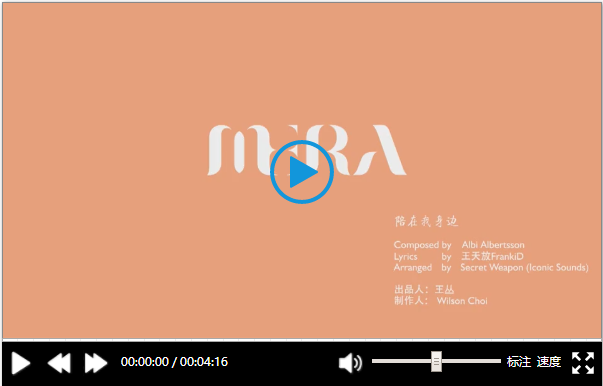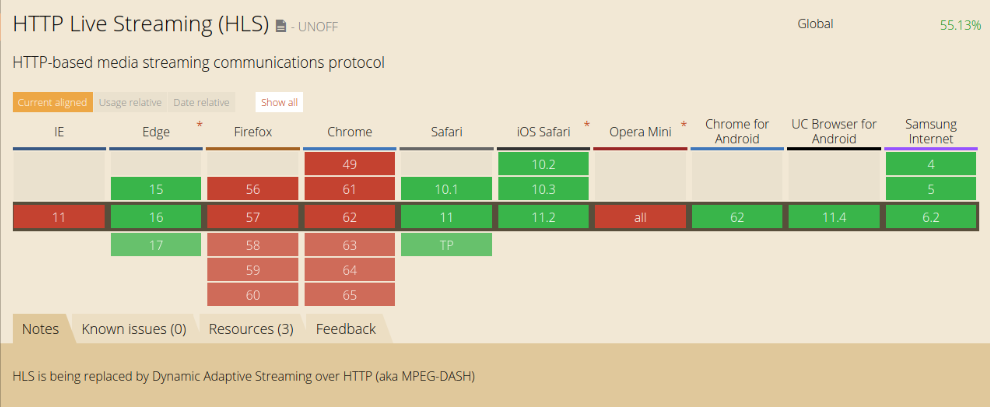video播放

还有很多细节没有处理,// todo 后面继续优化
H5 video
<video src="movie.ogg" controls="controls">
您的浏览器不支持 video 标签。
</video>
属性
| 属性名 | 值 | 描述 |
|---|---|---|
| autoplay | autoplay | 如果出现该属性,则视频在就绪后马上播放。 |
| controls | controls | 如果出现该属性,则向用户显示控件,比如播放按钮。 |
| height | pixels | 设置视频播放器的高度。 |
| loop | loop | 如果出现该属性,则当媒介文件完成播放后再次开始播放。 |
| muted | muted | 规定视频的音频输出应该被静音。 |
| poster | URL | 规定视频下载时显示的图像,或者在用户点击播放按钮前显示的图像。 |
| preload | preload | 如果出现该属性,则视频在页面加载时进行加载,并预备播放.如果使用 "autoplay",则忽略该属性。 |
| src | url | 要播放的视频的 URL。 |
| width | pixels | 设置视频播放器的宽度。 |
事件
本想自己归纳,发现w3上已经很细了all事件
<video id='player' src="../../../assets/video/1.mp4" controls="controls"
@play="videoPlay('play')"
@pause="videoPlay('pause')"
@playing="videoPlay('playing')"
@abort="videoPlay('abort')"
@canplay="videoPlay('canplay')"
></video>
自定义控制条
let myplayer = document.getElementById('player')
// 对象方法
myplayer.play() // 播放
myplayer.pause() // 暂停
myplayer.load() // 重新加载视频元素。
myplayer.addTextTrack() // 向视频添加新的文本轨道。
myplayer.canPlayType() // 检查浏览器是否能够播放指定的视频类型。
对象属性
myplayer.currentTime // 当前播放时间,设置获取,单位s
myplayer.videoHeight
myplayer.videoWidth
// 监听
myplayer.ontimeupdate = function(){} // 当前播放位置改变则执行函数
对象属性,方法
全屏(目前发现是最大的瓶颈)
video里面没有提供全屏的API,自定义控制栏最大的问题就在这里,只有自己实现
window.innerWidth 浏览器窗口的高度和宽度。
requestFullScreen
// 全屏 vFullScreen () { let element = document.querySelector('#playBox') this.videoDom.width = window.screen.availWidth if (element.requestFullscreen) { element.requestFullscreen() } else if (element.mozRequestFullScreen) { element.mozRequestFullScreen() } else if (element.webkitRequestFullscreen) { element.webkitRequestFullscreen() } else if (element.msRequestFullscreen) { element.msRequestFullscreen() } }, // 退出全屏 vExitFullScreen () { this.videoDom.width = 600 if (document.exitFullscreen) { document.exitFullscreen() } else if (document.mozExitFullScreen) { document.mozExitFullScreen() } else if (document.webkitExitFullscreen) { document.webkitExitFullscreen() } },这个方法最大的弊端是全屏后不能在显示控制菜单
position fixed 这个方案目前是最好的方案
注意这个两种全屏在效果上差别很大,requestFullscreen,是将整个浏览器铺满整个显示器屏幕,使元素全屏;而fixid是相对浏览器window
用的vue2实现的,上面两种方法实现全屏
<!--播放器--> <div id="playBox" :class="{'full-screen': isFullScreen}" style="border: 1px solid red"> <video :id="vId" @canplay="vCanplay" @play="handlePlay" @pause="handlepause" @click="vExitFullScreen"> <source src="../../../assets/video/1.mp4"> 您的浏览器版本太低,请及时更新 </video> <div v-if="barShow" class="control-bar"> <button @click="vPlay">播放</button> <button @click="vPause">暂停</button> <!--<button @click="vBig">全屏</button> <button @click="vSmall">退出全屏</button>--> <button @click="vLoad">重载</button> <button @click="speed(0.5)">慢放</button> <button @click="speed(1)">速度x1</button> <button @click="speed(2)">速度x2</button> <button @click="speed(3)">速度x3</button> <button @click="vFullScreen">全屏2</button> <button @click="vExitFullScreen">退出全屏2</button> <span>进度条:</span> <progress :value="currentTime" :max="duration" id="pro"></progress> <span>音量:</span> <input type="range" min="0" max="100" v-model="volumeValue" @change="setVolume" id="ran"/> <button @click="vFullScreen3">全屏3</button> <button @click="vExitFullScreen3">退出全屏3</button> </div>
data () {
return {
vId: 'player',
videoDom: '',
barShow: false,
volumeValue: 50,
duration: 0,
currentTime: 0,
timer: '',
isFullScreen: false,
}
},
methods: {
vCanplay () { // 监听视频可播放
this.videoDom = document.getElementById(this.vId)
this.barShow = true
console.log(this.videoDom.canPlayType('video/mp4; codecs="avc1.4D401E, mp4a.40.2"'))
this.duration = this.videoDom.duration
},
handlePlay () {
this.intervalTime()
},
handlepause () {
clearInterval(this.timer)
},
vPlay () { // 播放
this.videoDom.play()
},
vPause () { // 暂停
this.videoDom.pause()
},
vSmall () {
this.videoDom.height = this.videoDom.videoHeight
},
vBig () { // 设置小屏中屏大屏的方法,注意用的videoHeight
alert(this.videoDom.currentTime)
alert(this.videoDom.videoHeight)
this.videoDom.height = this.videoDom.videoHeight * 2
},
vLoad () { // 重新加载
this.videoDom.load()
},
speed (n) { // 播放速度
this.videoDom.playbackRate = n
},
vExitFullScreen () { // requestFullscreen实现全屏退出
if (document.exitFullscreen) {
document.exitFullscreen()
} else if (document.mozExitFullScreen) {
document.mozExitFullScreen()
} else if (document.webkitExitFullscreen) {
document.webkitExitFullscreen()
}
},
vFullScreen () { // requestFullscreen实现全屏
let element = this.videoDom
if (element.requestFullscreen) {
element.requestFullscreen()
} else if (element.mozRequestFullScreen) {
element.mozRequestFullScreen()
} else if (element.webkitRequestFullscreen) {
element.webkitRequestFullscreen()
} else if (element.msRequestFullscreen) {
element.msRequestFullscreen()
}
},
vExitFullScreen3 () { // fixed 实现全屏退出
this.isFullScreen = false
},
vFullScreen3 () { // fixed 实现全屏
this.isFullScreen = true
},
getStyle (el, name) {
if (window.getComputedStyle) {
return window.getComputedStyle(el, null)[name]
} else {
return el.currentStyle[name]
}
},
setVolume () { // 音量
this.videoDom.volume = this.volumeValue / 100
},
intervalTime () { // 周期获取当前播放时间
this.timer = setInterval(() => {
this.currentTime = this.videoDom.currentTime
}, 100)
}
}
>
#playBox {
video {
width: 600px;
}
}
.full-screen { // 全屏添加class
position: fixed;
top: 0;
left: 0;
bottom: 0;
right: 0;
z-index: 99999;
background-color: #000;
video {
width: 100% !important;
height: 100% !important;
border: 1px solid
}
.control-bar {
position: absolute;
bottom: 0;
}
}
.control-bar {
background-color: #fff;
width: 100%;
}
// TODO
RTMP
RTMP是Adobe开发的协议,无法在iPhone中兼容,故目前兼容最好的就是HLS协议了
h5播放m3u8
m3u8 是一种基于 HTTP Live Streaming 文件视频格式;HLS, 是由Apple公司定义的用于实时流传输的协议,HLS基于HTTP协议实现,传输内容主要包括两部分,一是M3U8描述文件,二是TS媒体文件。原理上是将视频流分片成一系列HTTP下载文件。.m3u8格式视频需要两个条件:
- 支持H5的video标签;
- 在条件1的基础上同时需要支持.m3u8类型的视频播放。
android手机浏览器只要支持H5的video标签就基本上支持.m3u8这种类型的视频播放;而PC端浏览器即使支持H5的video标签,也不支持.m3u8视频的播放。浏览器的兼容性:

m3u8 是一种基于 HTTP Live Streaming 文件视频格式
我看pc解决m3u8还可通过flash解决 ,// TODO 之后有空在写这部分
视频加密Blob
本想给个输入框,输入视频地址播放,发现发现很多直播,视频都是blog:http加密过得 先看下别人的理解
之前一直不知道为什么f12看到很多直播平台,视频网站的视频地址都是blog:http开头的,接触hls.js大概会明白些.都使用hls.js绑定后的地址就是这样
video.js
video.js给出了m3u8的解决方案文档
// TODO 学习video-contrib-hls是如何实现
hls.js
再安利一个非常纯粹的方案,就是 hls.js 它需要你手进行 video 的绑定。 // todo 很值得深入了解
这是一个使用video播放m3u8的简单例子:
<!DOCTYPE html>
<html lang="en">
<head>
<meta charset="UTF-8">
<title>Title</title>
<!--<script src="https://cdn.jsdelivr.net/npm/hls.js@latest"></script>-->
<script src="hls.min.js"></script>
</head>
<body>
<video id="video" controls></video>
<script>
if (Hls.isSupported()) {
var video = document.getElementById('video')
var hls = new Hls()
hls.loadSource('https://video-dev.github.io/streams/x36xhzz/x36xhzz.m3u8')
hls.attachMedia(video)
hls.on(Hls.Events.MANIFEST_PARSED, function () {
video.play()
})
}
</script>
</body>
</html>